Everyone says owning chickens is easy, and for the most part it is relatively easy. They’re fairly low maintenance, but still require work just like any pet.
When we moved to the country, we knew we wanted to get chickens. While my husband had experience with chickens growing up, he wasn’t old enough to truly understand the ins and outs of livestock ownership. So this adventure was fairly new to the both of us.
We did our research, learned about what to expect and we did our very best to cover all the bases. But there’s information that was left out from the research for newbie chicken owners. They are simple things that, when looking back on it, are obvious to experienced people, but not obvious to a new livestock chicken owner. Here’s some of the things we’ve learned along the way and wish someone told us as newbie chicken owners.
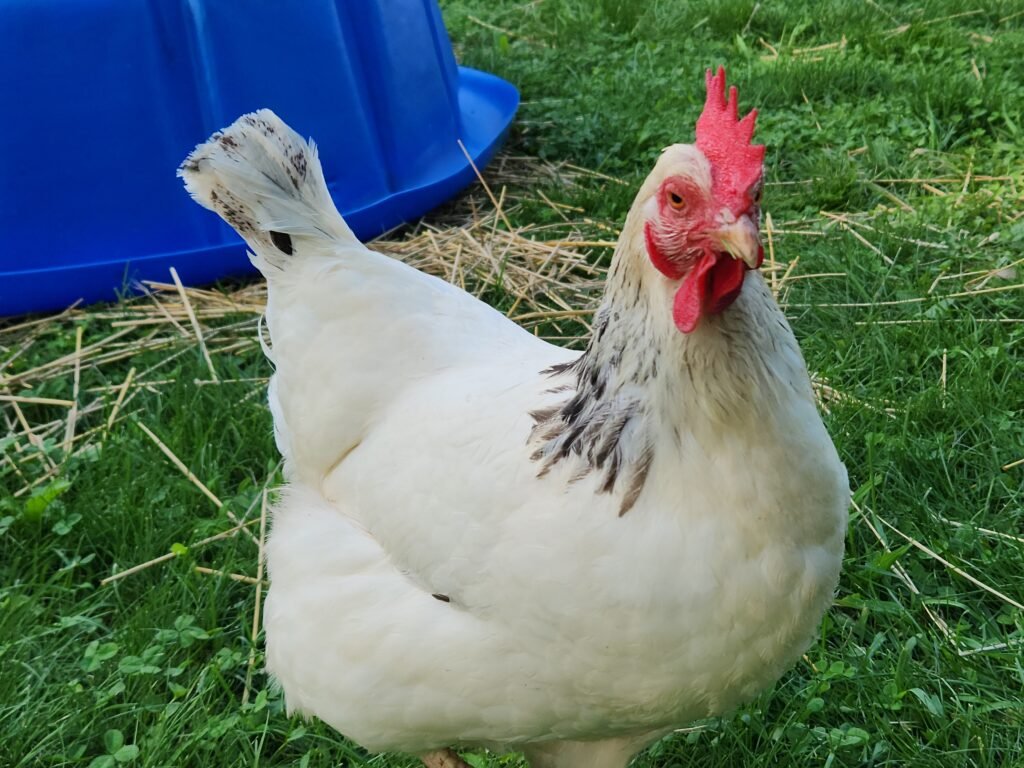
Getting Your First Chickens as a Beginner
Getting chickens seems easy and it might be where you’re from, but in Ontario, Canada, there are only 3 hatcheries that sell chickens and those hatcheries have a wide variety of breeds to choose from. Including day old chickens you can raise, or 4 month old’s that are ready to lay eggs.
But what they don’t tell you, is that you can only order them for certain times of the year, and if you miss the cut off date then you’re out of luck until the next ordering window a few months away.
We knew we wanted chickens in the spring, but we didn’t order them in the winter like you’re supposed to, so we were unable to buy our first batch of chickens from a hatchery.
We turned to Kijiji (the Canadian eBay of sorts) to see if anyone was selling off extra birds that spring. Luckily, we found a farmer that was selling 3 of his chickens. It was less than we wanted, but we figured it was a start!
These birds were about 4-5 months old and had just started laying, which was the type of chicken we wanted – but we learned overtime that buying so few chickens at once and buying ready to lay chickens comes with a bunch of downfalls.
The biggest challenge being that after a few years of them seeing us and having us feed them, they’re still so scared to come near us. The chickens won’t come close to us or let us pick them up. This has been a major downfall for whenever they get ill or wounded. Which is another BIG area of chicken ownership we were not expecting.
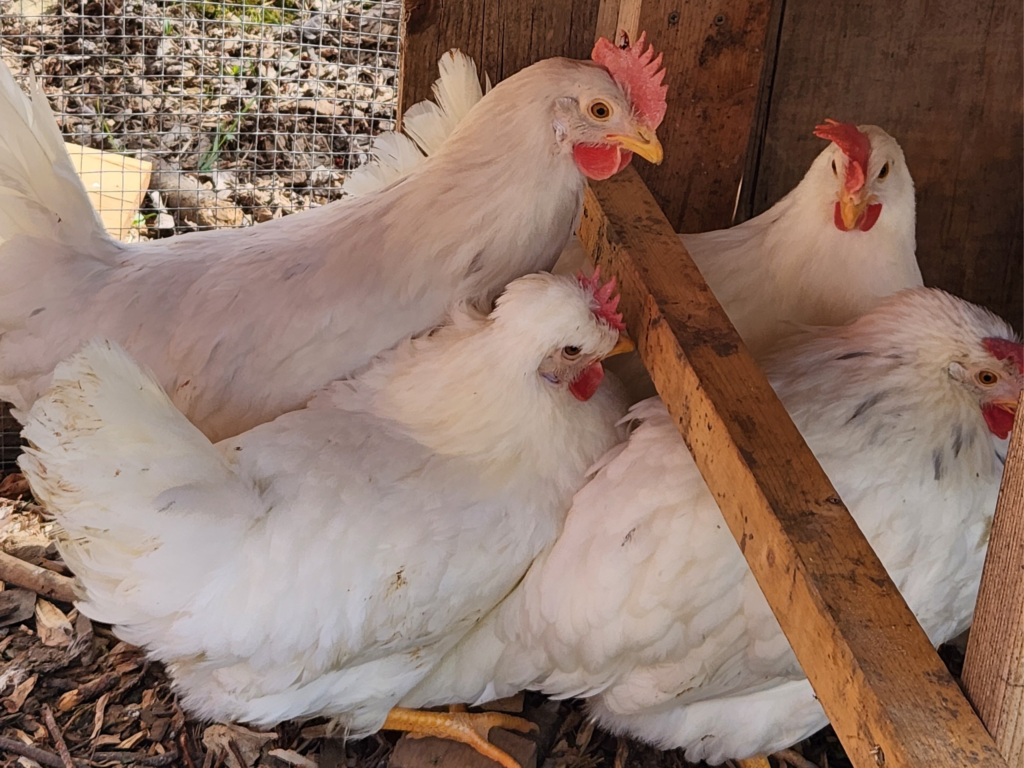
Conclusion on Getting Your Chickens:
- Getting your chickens isn’t as simple as just getting your chickens whenever you’re ready. You need to think about it months in advance, when you’re going to build the coop, how many you want, the breeds you want, etc.
- Day old chickens means you need to raise them indoors for a few months with special food and lighting and warming conditions
- 4 month old’s (ready to lay) chickens means they didn’t grow up with you and chickens are, well, ‘scared chicken’. So when you need to capture them or go near them, they might not ever be comfortable with you.
Chicken Illnesses/Wounds
Since chickens are livestock animals that live outside, there’s going to be things that get to them. This is totally normal and expected! However, we did not expect it to be a continuous hurdle after hurdle with our livestock’s health and wellness. Here’s a quick overview of each situation we’ve encountered thus far.
Mites:
The first hurdle we dealt with in the first fall/winter was mites. Not to get too much into this one, but essentially the mites were living in the coop and causing the birds to sneeze a lot. So we had to find a solution for that and it thankfully worked well.
Frostbite and Cannibalism:
When we had our chickens in that first winter, some nights the temperature got down to -30 degrees Celsius. One of our bigger chickens, with her bigger comb, got a bit of frostbite on the tip. This was to be expected and common. We did our best to keep them as warm as possible without preventing the much needed ventilation that’s required in the coop.
As she was healing one of the other chickens decided to peck at it and it started to bleed, so all of the chickens started to peck at her (because apparently chickens go wild at the sight of blood like sharks)? We had to immediately remove her until she healed up.
(Remove her to where? Something else people don’t tell you about as a newbie chicken owner. I’ll talk about that more later). Thankfully none of our other chickens had issues healing their frostbite, but it was constantly something we had to watch out for.
Unknown Illness:
This past summer, one of our original chickens started hobbling around and having diarrhea. None of the other chickens were affected by this. When we finally caught her, examined her, felt for her being egg-bound, and scoured the internet for an answer but couldn’t find anything that explained what she had. But a few days passed and she got better on her own!
Alas, 2 weeks passed and then she started exhibiting the same symptoms again. We gave her a warm epsom salt bath, separated her from the flock and within 2 days she died.
Now, we thought about taking her to the vet – but let’s be honest about the math here. While she was personally my favourite chicken, the vet would have cost upwards of a couple hundred dollars and quite possibly provided us with no answers. Or, we could get a new chicken the same breed and younger in age, for $18.00 CAD…
At the end of the day if you’re going to have chickens, you need to decide if they’re livestock or pets – you can try to have them be both, but then a decision like this will come up and you’re going to have to make a choice.
Currently, one of our chickens has something wrong with her hip or ligament, or something in that area. She’s been hobbling around and can barely get out of the coop and won’t run to the food like normal. So, just like the other chicken illness we’ve already listed above, we had to remove her from the group until she can heal properly. So far she’s recovering well, she’s back with the other ladies but she’s still moving slow and still hobbling a bit. Ideally she’ll be back to normal in a few days.
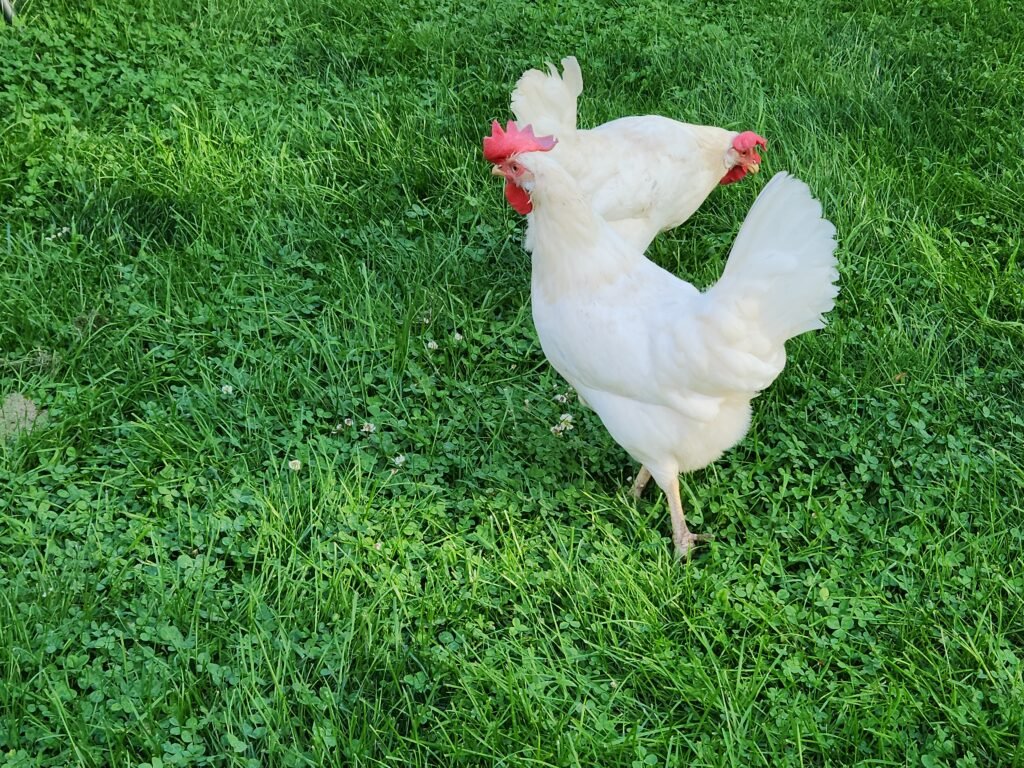
Predators:
Lastly, our saddest and hardest chicken fail. Just before our first winter, I believe it was in November, a predator got into our run/coop.
Our run was completely covered in chicken wire, we buried the chicken wire a foot down into the ground and back filled it with dirt and rocks. The coop itself only had some small open holes near the roof for ventilation. This run and coop were built to protect the ladies from mountain lions, raccoons, coyotes, hawks, and any other large predator you can think of.
But the one predator we didn’t think of was, the weasel.

Thankfully we looked out the window that afternoon precisely seconds after it got into our run and took down one bird. We scared it away and put the remaining ladies into the coop thinking it was protected enough from a weasel.
Well, that night two died in the coop while the others were petrified and huddled on the roost. We set out rat traps for it and that seemed to have done the trick because we never saw the weasel or that rat trap again. Needless to say we then ripped out all of the chicken wire and replaced it with hardware cloth and used hardware cloth on every nook and cranky in the coop.
The chances of a weasel coming by the way, is very rare. They are solitary animals that typically cover an area of up to 300 acres. We were just very unlucky. That happens in livestock ownership – sometimes you just get unlucky.
Removals/Temporary Infirmaries:
This has to be my biggest issue with the lack of information around this when we wanted to get chickens as newbie owners. No one tells you that you need to create a separate coop/space for chickens when they need to be separated from the others.
To this date we’ve had to temporarily remove three chickens from the flock and assimilate new birds three separate times. That’s six times, SIX TIMES we could have used a temporary separate coop/space for the chickens since getting them only a few years ago.
We have a greenhouse and thankfully that’s been a temporary fix during the fall/winter when these ailments have occurred, but in the spring or summer we don’t have a space for the ladies other than an enclosed cat carrier in our shed. It’s not ideal.
While it would not have made a difference to whether we would own chickens, just knowing that this was something that was useful and important to set up prior to owning chickens would have been helpful.

Conclusions on Illnesses/Wounds
- Be prepared to have a separate small coop/area for when you need to remove chickens from the flock temporarily.
- You will never be prepared for everything that can happen to your chickens. But do as much research as possible beforehand so you’re the most prepared you can be.
Assimilating Chickens and Alpha Females
As I’ve previously covered, we started with three egg-laying chickens in our first spring, then in the fall we got four more egg-layers (4 month old’s) from the hatchery. We got two of one breed and two of another. These four chickens did not arrive at the same time. Two came two weeks earlier than the others and that make our chicken assimilation THAT much harder.
Our three OG chickens are Colombian Rocks (white with a bit of black feathers around the neck and a few on the tip of the tail). The first batch of two that arrived were Lavender Orpington (beautiful fluffy grey birds). This variety is very docile and good with kids, which we thought would be an excellent addition to our flock.
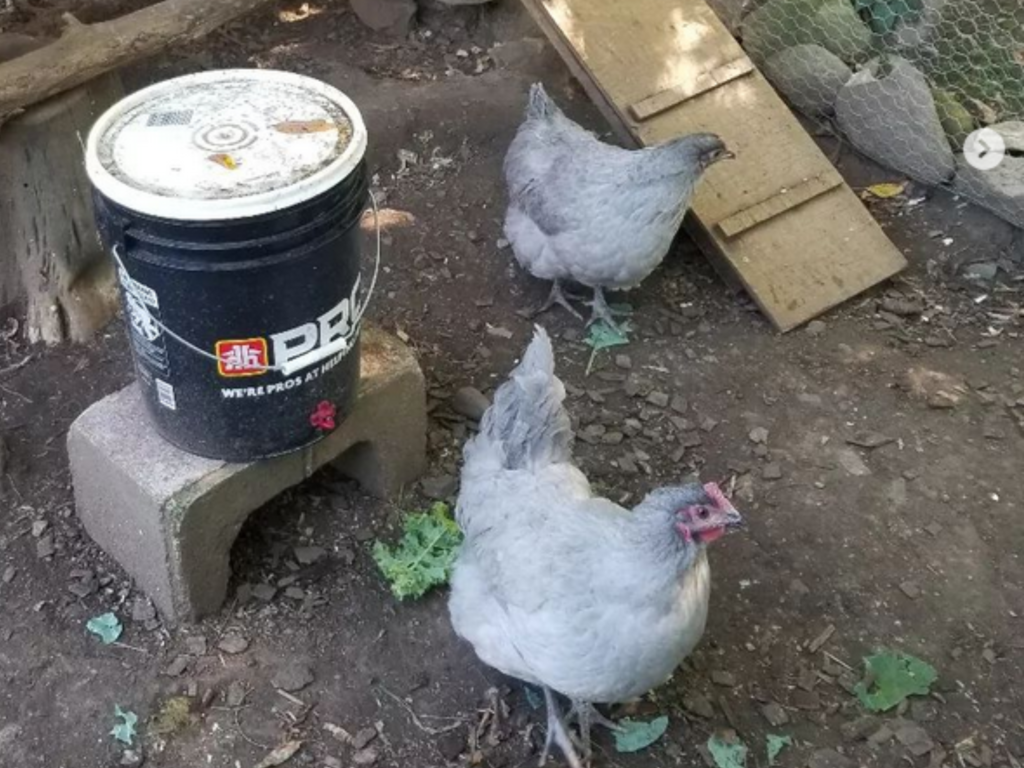
First, you cannot just let the new birds in with the old. You have to slowly integrate them by bringing them beside the old ones, in either the temporary extra run you’re supposed to build beside the main run or by creating a divider in your current run. This takes a few days before they can/should be added in with your old flock.
There are 2 reasons for that
- 1. Bullying.
- 2. Potentially spreading new illnesses to your flock.
Even then, our original three did NOT like these two new grey birds and would chase them, dominate them and peck at them. It was here with our one week of 5 birds that we saw the pecking order first evolve.
Then the next two arrived. These were Blue Azure, they are completely white and smaller in size but lay blue eggs. We tried to keep these ones separate with our divider but they would just fly – yes fly, over the top of the divider into the other side and sit on-top of the highest outdoor roost and watch from above. None of the other birds dared to venture near that top roost before. So they managed to avoid being at the bottom of the pecking order. After we lost our two lavender orpingtons and one blue azure to the weasel, we ordered four more azure blue’s for the following spring.
Our alpha female unfortunately was the one that passed away from unknown causes. A new chicken took over the alpha position after by repeatedly pulling out all of the ‘second’s‘ newly grown feathers from her spring molt. (Molting is when chickens pull out their feathers in the fall, but sometimes spring, and grow new feathers).
It happened over and over and over again and now we’re in the fall and she’s still growing back her feathers. Thankfully that alpha bird is the one with the hip injury so she’s getting some separation time from the others. Who will be the alpha female now? I’m not sure, but we’ll see.
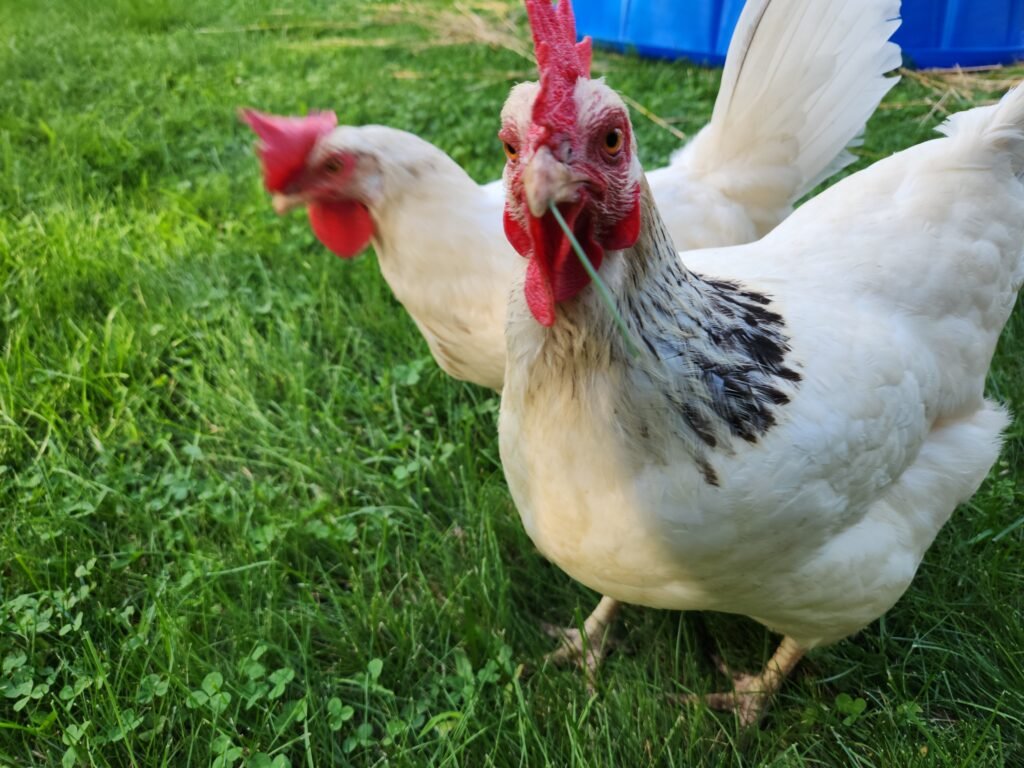
TLDR: Lessons and Things They Don’t Tell You About Getting Chickens
- #1 When possible, always buy day old’s and raise them up – it will make treating them easier when they’re older.
- #2 If you have to buy egg-layers (4 month old’s) try to buy as much as your flock as possible at once. Small integrations is not worth the trouble
- #3 Build a separate coop/run or as I call it, a chicken infirmary
- #4 If you’re going to get more chickens to add to your flock, be mindful about colour – chickens are racist towards other chickens.
- #5 Ensure your coop is ALL types of predator proof. Get a rooster too if possible to help with protection!
- #6 Things just happen to livestock sometimes. Not much you can do about it.
Would I Do It Again?
Yes. I love our fresh eggs. It’s good for my children to learn where food comes from. It’s good for the soul to get out of the house daily and to be rooted in real life. Want more chicken content?
We also have plenty of medicinal herb guides, growing guides, seed saving guides and our recipes. We are growing our website with more articles all the time, and we invite you to grow with us. If you have any questions about chickens or would like to share some of your knowledge with us please leave a comment below. Happy Gardening!




